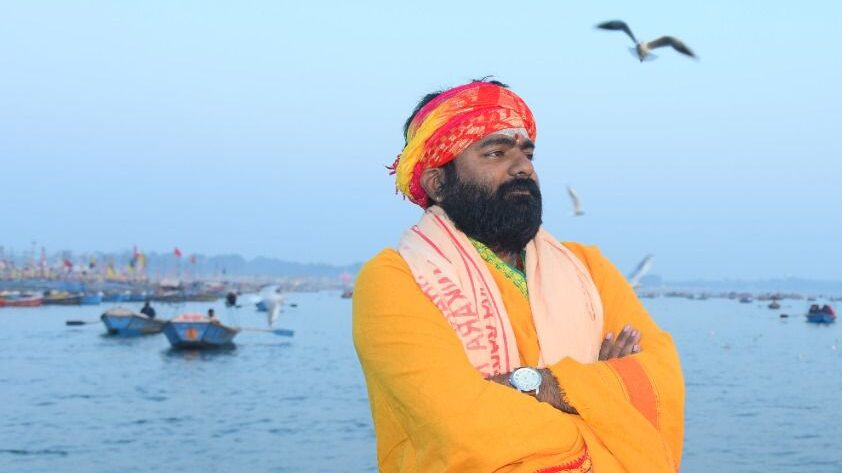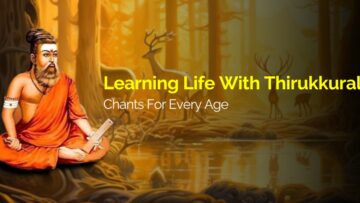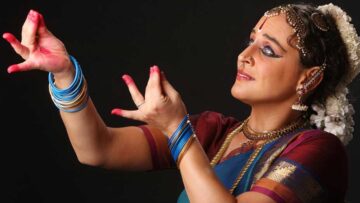In January 2024, the founder of the Saptarushi Veda Pathashaala Shri Madhav Sarma presented a vigraham of Adi Shankara Bhagavadpada to Shri Hari Kiran Vadlamani, who through Indica has been committed to a manasik yatra of Shankara’s path. Madhav Sarma garu, based in Vishakapatanam, in Andhra Pradesh, believes that Dharmo Viswasya Jagathah Pratishta (It is righteousness which holds up the universe) and has dedicated his life to the protection and furtherance of Dharma and the teachings of Adi Shankara Bhagavadpada.
Started in 2009, the paatashaala was started by his father in order to ensure that the Veda and its values are not lost to the next generation. This family believes that whether or not the present Hindu society changes or not, it is important that there are people whose life-mission is Vedic learning.
As society moves away from the core of the Veda, exhausting the Chatustayam, or four diplomatic principles – “Sama (process of pacifying), Daana (charity), Danda (punishment), Bheda (division), only Veda is the upayam, says Madhav Sarma garu. “It is only with these mantras that we can fight adharma. We have rakshsasas today who are threatening our dharma, our Vedas. For those who have rakshasa tatvam in their minds, we can only change their attitude with Vedas.”
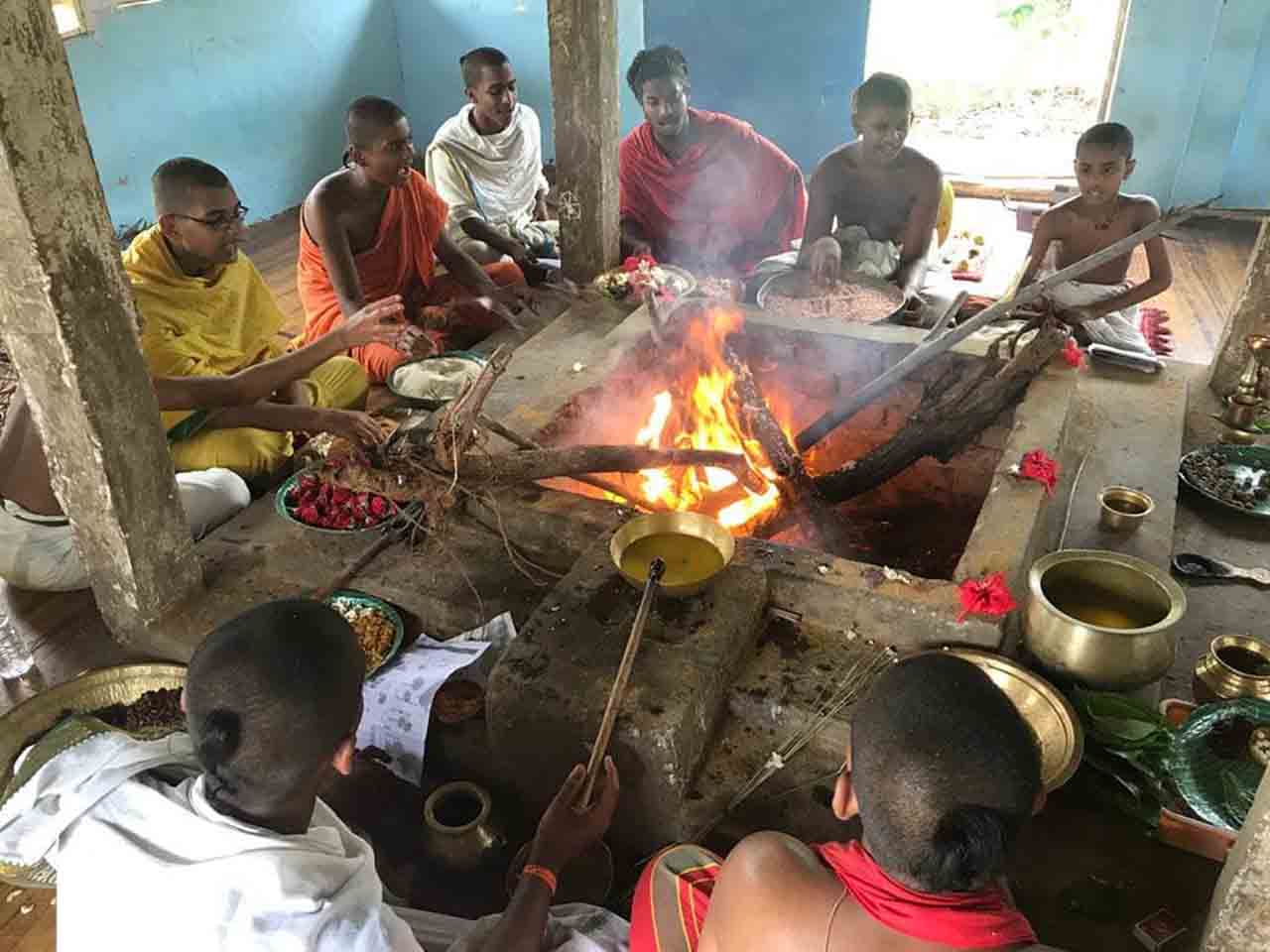
To this end, he has been going on a Yatra across India to spread the message of Adi Shankara which is to unite the nation through our Vedic tradition. He spoke to Indica from Gokarna, and was on his way to Maharashtra the next day. Asked how we can unite in this cause, he looked around him, where his team was busy cooking the night meal. “All these Vedic pundits have come from different regions. However they recite the mantras together, there is no difference. The acharya vyavahara (rules of religious activity) differs from state to state. For the dharma rakshana of the Veda we have chosen Vaidika margam. You can decide if you want to recite stotras, conduct yagnas, or do bhajans. Everyone has to come together to do their bit to make sure our dharma is not harmed. We need to come under the grace of Jagadguru, under one umbrella. We need to come together to work for the future of Hindu Sanskriti Sampradaya, from wherever we are.”
Madhav Sarma garu believes there should be a Veda Dinotsava to honour our rishis and their wisdom. Over the years, he has been marking this day in different parts of India. The purpose of the Vedas, the purpose of the sound of the Vedas, is the welfare of the world. And in the words of the Kanchi Parmacharya Shri Chandrashekandra Saraswathi, “the remedy for all the ill of the worlds, all its troubles is the return of all to Vedic Dharma.”
Madhav Sarma garu says that their mission is to not restrict Vedic education to traditional schools only but to make the entire nation be aware of its heritage. For the last 10 years, he has made efforts to spread information about the Vedas to the common man through yatras to villages and towns across India. “The reason we started this yatra was to follow the footsteps of Shankaracharya. He did both Vedam pracharam (propogation) and parirakshana (preservation). In the same way, we would like to do both. With the same uddhashem (objective) we did the roopakalpana (design) of the Veda Bharata Parikram Yatra. Within our limitations we got together all the veda pundits who are with us and we went to every street, village, patanam (district) where we felt there was a need to promote the teachings, mantras, and knowledge about our heritage. In order that the coming generations know about the wealth of Vedic heritage, we roam from street to street.”
Every Ashada Shuddha Panchami, which is referred to as Veda Panchami, they have proposed the idea of ear-marking a day for the Veda, just like there is for Yoga. Reflecting at the special significance of this day, Madhav Sarma garu says that while usually we need to refer to the Panchangam in order to see muhurat for an auspicious function but not on this day when the whole day is auspicious. “In the past there was a niyama that all Brahmins, for one month in Ashada, had to do Dharma pracharam. Therefore Ashada was seen as a shunya masam, as no auspicious ceremony was held at this time. Over time, this has stopped. In order to emphasise the importance of this Vedic commitment, I asked all the Shankaracharyas and vedic pundits if this was alright by them and they were very supportive.”
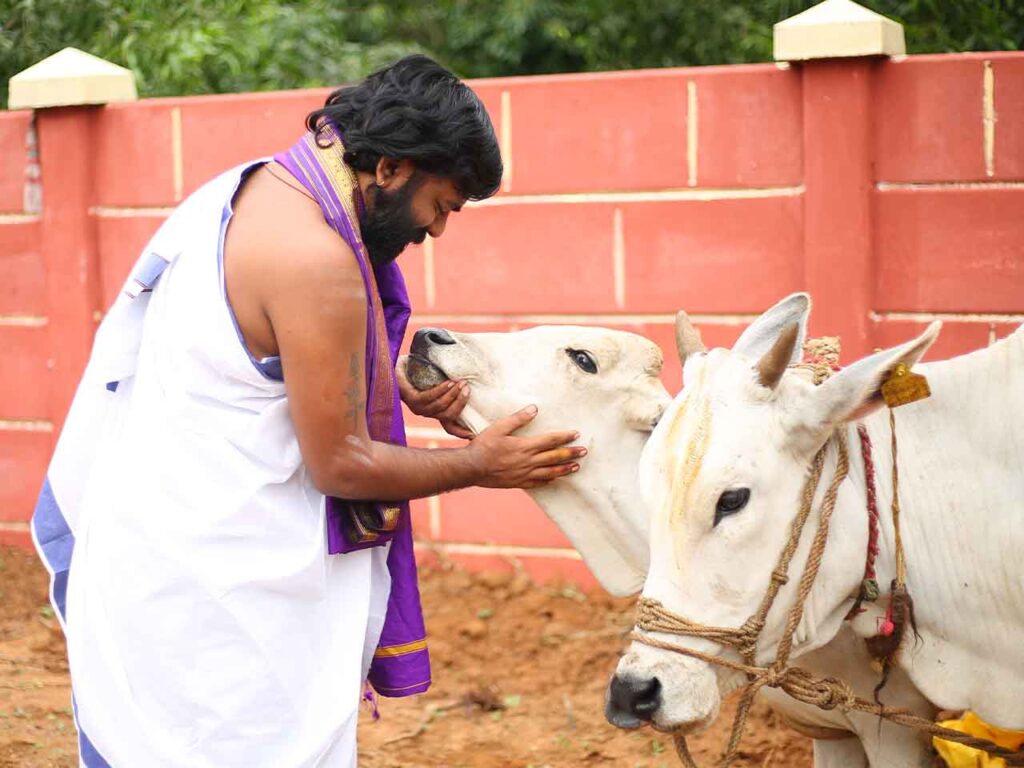
“It would be good if Veda Day can be celebrated at the international level. Even before we had a Yoga day, there were so many people doing Yoga. But once it was declared as an international day, even Arab countries are following yoga. More people are doing yoga, there is greater awareness. We bring together almost 500 Vedic pundits and mark the day. In order to make others join this movement, every year we celebrate this day in a different state. One day is dedicated to one Vedam.”
The yatra has been conducted for over a decade now and Ayodhya has always been in the route. He says they have been praying for the sthapana of the Ram mandir in Ayodhya every year with even the Police Commissioner joining in the prayers. This year, they plan to visit Ayodhya not only do Veda parayanam, but also to celebrate Veda day in Ayodhya. “We plan to bring 108 Rig Veda pundits to Ayodhya from all over India. They will do 108 iterations of the Rig Veda. That is our sankalpam.” He adds that we are the first to know of this.
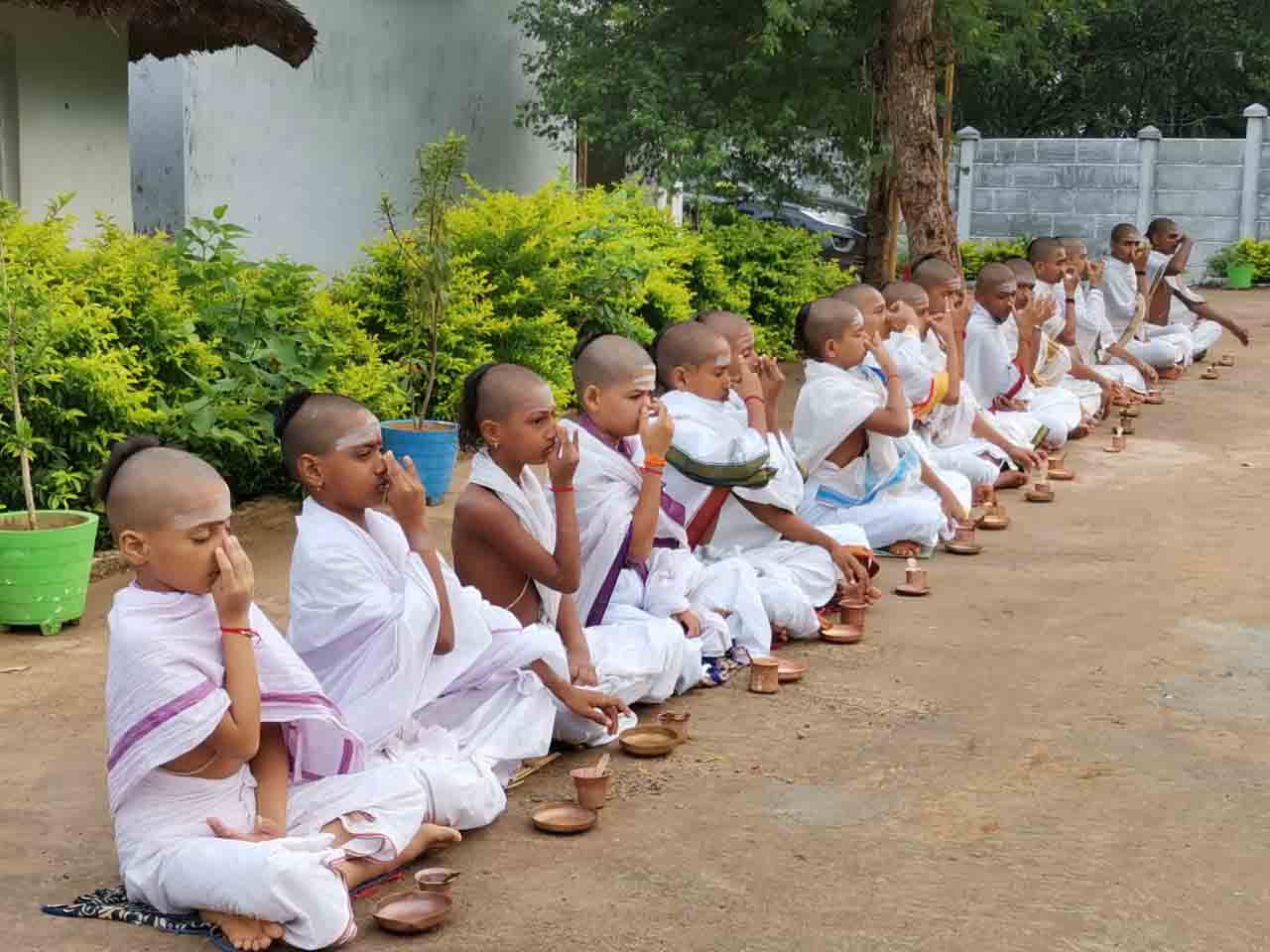
When Veda day was celebrated at the Ma Sharda shrine in Kashmir in 2022, they had made a sankalpam that the temple should reverberate with prayers. They had recited the Durga Saptashati 108 times near the banks of the Sindhu river. Fortuitously, the prathishtana was done by Shankaracharya of Sringeri on the same day, June 4th, of the following year.
YATRA
Every January there is a one month yatra for Veda pracharam. They are following the route that Adi Shankara Bhagavadpada took. In these 30-40 days, the minimum distance covered is 21,000 kms mostly by vehicle. The padayatra distance is usually between 300-500 kms. They cook their own food during the travel. It is not like a normal pilgrimage by people, he adds. “It has to be very Dharmic, just the way Shankaracharya did. Because of the modern context, we are using vehicles, which has made it easier for us. It is amazing how he did his entire paadayatra of Bharata desham on foot at such a young age.”
In Kanchi matham are housed details of Adi Shankaracharya’s routes. There are basicially four peethams – Purvamnaya is the Rig Veda peetham in Puri, Dakshinamnaya is the Yajur Veda peetham in Sringeri, Pascimamnaya is Sama Veda peetham in Dwaraka, Uttaramnaya is Atharva Vedam in Jyotir matham in Badrinath. The trust prepares route maps to these four places. In addition Shankara has visited smaller places like Simhachalam in Vizag and so they visit those places too. Night is for prayanam as they travel all night. They eat one meal a day – satvik aharam. Their visits to temples are kept simple, to the chants of Jaya Jaya Shankar, Hara Hara Shankara. “We are not after VIP darshans, our aim is that our parayanam should be heard by as many people as possible.”
There are around 25 members on the yatra, each responsible for a particular Vedic rite. The Chaturveda pundits know all the four Vedas. Scholars of each of the Vedas do parayanam, some do abhishekam, some do homam. “We are praying for lokakalyanam (welfare of the whole world). Our pujas, our mantras, are not for our personal benefit, but for welfare of everyone. When someone calls us for a homam and gives a dakshina, our prayers are for them. But when we pray for Bharatakandam, we have to transmit the mantra shakti to many people. We ask them to chant Gayatri mantram, so that they are brought into this movement. Through these mantras and pujas we are purifying the whole place.”
India today is moving towards a Western model of pursuit of material happiness. Our acharyas have shown the way how Vedic practices, by turning us towards matters of the Self, can bring harmony and peace. Vedantins around the world have embraced this whole-heartedly. So should the Vedas be protected, from the incursions of those who don’t respect it or understand it fully? Madhav Sarma garu says that they are shielding the Veda (parirakshana) but if they don’t propogate it will disappear. “Those who are interested in studying the Veda should be encouraged to come up, that is our effort. Today, the number of Veda patashaalas is increasing, but not the number of students. The number of temples is increasing but not the number of archakars (priests). So we are trying to balance promotion and protection. Our people are forgetting that we have a huge treasure in the Veda. We are trying to bring this forward.”
Ofcourse, even in the turn of this century, as industrialization took hold, people would ask: Can being a Vaidika allow one to lead a life of comfort? He says this project is not only about the livelihood of Brahmin priests whose life and families depend on the Veda. It is also the cultural heritage of a great civilization that needs to be protected, he adds. We need to do yagnas/yagas by ourselves as patronage from Kings and kshatriyas have long gone. “Now the government has taken their place, but if they don’t do it and we don’t have kings, who will perform yagnas? There may come a time when people may want to learn the Veda, but the Veda should survive for that.”
To this end, their main activity is Veda parayanam, of all the kandas of the Rig vedam, all the mantras, adhyayas, ashtakas. All the four Vedas – Rig Veda, Yajur Veda, Sama Veda and Atharva Veda are being taught. Madhav Sarma believes that even if people listen to the mantras, the place is energized. The reason that Veda adhayanam is alive in Andhra today is because of the continuity of the Guru shishya parampara. “My father and forefathers were Vedic scholars and I will teach my children the same. In other states, however, it has got cut after some generations. They are pursuing other professions. They have left their own vrutthi (profession in which generations have been trained) and gone to other vrutthis. There should be a rule that our children should compulsorily do Vedam adhayananam.”
Our acharyas have shown us the way. They have told us, “This is a Dharma that requires to be practiced. The Vedas are the breath of God and it is our duty to protect the Dharma not just to God but to all the rishis who have bequeathed this treasure to us.” It is people like Madhav Sarma garu who are ensuring this is passed on to the future.



